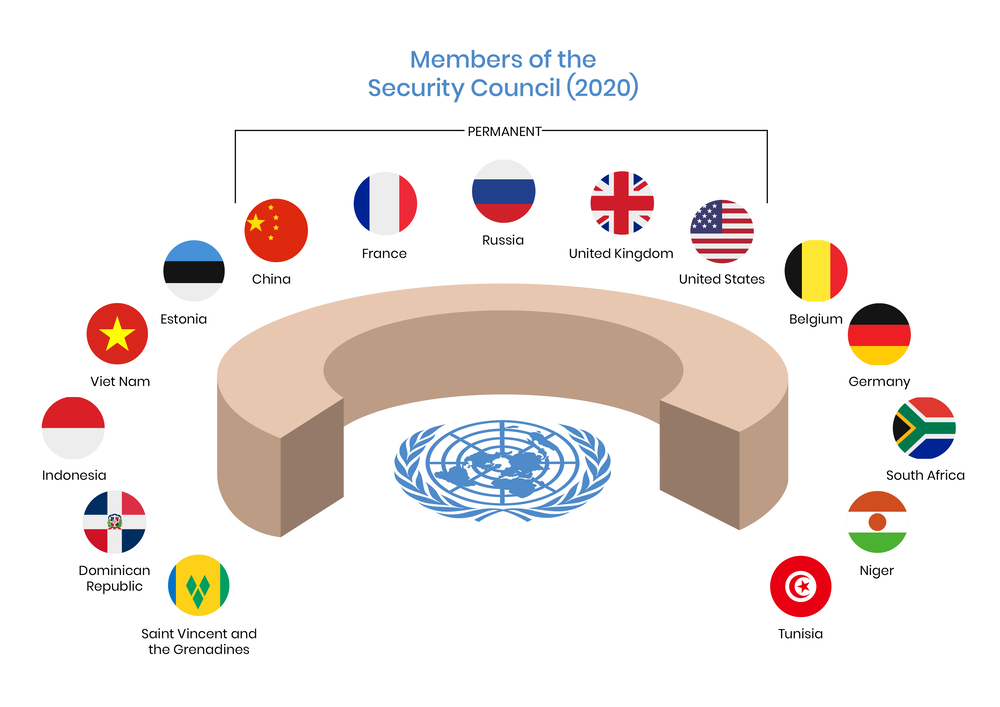CONTENTS
- India and UNSC
- Rohini RH-200
- White Fly
- Carl-Gustaf M4
India and UNSC
Context:
Recently, External Affairs Minister said there is greater support for India to be a permanent member of the UN Security Council and also a broad global consensus over the need to reform the Council.
Relevance:
GS-III: Environment and Ecology, GS-II: International Relations
Dimensions of the Article:
- United Nations Security Council
- Membership
- Functions and Powers of UNSC
- India’s Case for obtaining the UNSC Permanent Member Status:
- What is the benefit to India if made a permanent member of UNSC?
United Nations Security Council
- The Security Council is one of the six main organs of the United Nations.
- The Permanent Residence of UNSC in the UN Headquarters New York City, USA.
- Its primary responsibility is the maintenance of international peace and security.
- While other organs of the United Nations make recommendations to member states, only the Security Council has the power to make decisions that member states are then obligated to implement under the Charter- Hence, it is the only body of the UN with the authority to issue binding resolutions to member states.
- Resolutions of the Security Council are typically enforced by UN peacekeepers, military forces voluntarily provided by member states and funded independently of the main UN budget.
Membership

- It has 15 Members (5 as Permanent Members and 10 as Non- Permanent Members), and each Member has one vote.
- The Five permanent members are: China, France, Russian Federation, the United Kingdom, and the United States. Each of the Permanent Members has Veto Power over every decision of UNSC.
- The Ten non-permanent members are Elected for two-year terms by the General Assembly.
- Each year, the General Assembly elects five non-permanent members (out of ten in total) for a two-year term. The ten non-permanent seats are distributed on a regional basis.
- As per the rules of procedure, a retiring member is not eligible for immediate re-election and the election is held by secret ballot and there are no nominations.
- The presidency of the Council rotates monthly, going alphabetically among member states.
Functions and Powers of UNSC
Under the United Nations Charter, the functions and powers of the Security Council are:
- to maintain international peace and security in accordance with the principles and purposes of the United Nations;
- to investigate any dispute or situation which might lead to international friction;
- to recommend methods of adjusting such disputes or the terms of settlement;
- to formulate plans for the establishment of a system to regulate armaments;
- to determine the existence of a threat to the peace or act of aggression and to recommend what action should be taken;
- to call on Members to apply economic sanctions and other measures not involving the use of force to prevent or stop aggression;
- to take military action against an aggressor;
- to recommend the admission of new Members;
- to exercise the trusteeship functions of the United Nations in “strategic areas”;
- to recommend to the General Assembly the appointment of the Secretary-General and, together with the Assembly, to elect the Judges of the International Court of Justice.
India’s Case for obtaining the UNSC Permanent Member Status:
- India joined the U.N. in 1945 (2 years before independence) and India has been an active participant in all initiatives undertaken by the UN like Millennium Development Goals, Sustainable development goals and various UN summits, including on climate change
- In the past, India’s was offered to join the UNSC by both the superpowers, the US and the then Soviet Union in 1950 and in 1955 respectively, India denied the offer due to Cold war politics in that era.
- Currently, there are more than 6,700 troops and police from India who have been deployed to UN peacekeeping missions, the fourth highest amongst troop-contributing countries (having almost twice the number of peacekeepers deployed on the ground by the Permanent 5 countries)
- India has been elected for seven terms for a two-year non-permanent member seat till now.
- India is the world’s fifth-largest economy by nominal GDP and third largest by purchasing power parity and maintains the world’s second-largest active armed force (after China) and is a nuclear-weapon state.
- India’s acquired status of a Nuclear Weapons State (NWS) in May 1998 also makes India a natural claimant as a permanent member similar to the existing permanent members who are all Nuclear Weapon States.
Who Backs India for a Permanent Seat in UNSC and who Doesn’t?
- India’s bid for permanent member of UNSC is now backed by four of the five permanent members, namely France, Russia, United Kingdom and United States.
- On 15 April 2011, China officially expressed its support for an increased Indian role at the United Nations, without explicitly endorsing India’s Security Council ambitions.
- A few months later, China endorsed Indian candidacy as a permanent UNSC member provided that India revokes its support for Japanese candidacy.
- As part of the G4 nations, India is supported by Brazil, Germany, and Japan for the permanent seat.
What is the benefit to India if made a permanent member of UNSC?
- Permanent seat in the UNSC, would provide India with the much-needed leverage to expand its geo-political and geo-economic clout globally.
- Inclusion of India into UNSC will help in transforming its status from being a responsible stakeholder and pave the way for playing its part as one of the global rule makers.
- Indian presence at the Security Council would ensure Indian interests are not neglected amidst the decisions of great power politics.
- India will gain strength to act as a counterweight to China as China is growing to be a more potent rival, an emerging hegemony in Asia and an ever-increasing strategic and security concern.
- India will gain the ability stall any possible intervention by China, a permanent member which can take action at the behest of its ally Pakistan.
How does India’s Inclusion as permanent member help UNSC?
- India in many ways is a sui generis (unique) country, the only example in history of a billion-plus people working together in a democratic framework, hence: A seat for India would make the body more representative and democratic. With India as a member, the Council would be a more legitimate and thus a more effective body.
-Source: The Hindu
Rohini RH-200
Context:
The Indian Space Research Organisation (ISRO) is planning the 200th successful launch of the Rohini RH-200 sounding rocket in a row.
Relevance:
GS III: Science and Technology
Dimensions of the Article:
- Details
- About RH-200
- What are the Sounding Rockets?
Details:
- The Rohini sounding rocket RH-200 has made 198 straight successful flights.
- World Space Week (4th-10th October) events will include the 199th launch in October 2022.
- The 200th will occur either at the end of October or the start of November 2022.
About RH-200:
- The two-stage RH-200 rocket can carry research payloads up to a height of 70 km.
- Solid motors power the RH-200’s first and second stages.
- The RH-200 rocket had been propelled by polyvinyl chloride (PVC) for many years.
- The first RH-200 to successfully launch from the TERLS in September 2020 was using a new propellant based on hydroxyl-terminated polybutadiene (HTPB).
- HTPB-based propellants are more energetic, have greater mechanical and interface qualities, and have fewer flaws than PVC-based propellants because of lower processing temperatures.
- The number “200” in the name refers to the rocket’s mm-diameter. The RH-300 Mk-II and RH-560 Mk-III are further operating Rohini models.
What are the Sounding Rockets?
- Sounding rockets are one or two stage solid propellant rockets used for probing the upper atmospheric regions and for space research.
- Sounding rockets take their name from the nautical term “to sound,” which means to take measurements.
- They also serve as easily affordable platforms to test or prove prototypes of new components or subsystems intended for use in launch vehicles and satellites.
History:
- On November 21st, 1963, the Thumba Equatorial Rocket Launching Station (TERLS) was founded. The magnetic equator of the earth is not far from its southern tip.
- The Indian Space Program got its start in 1963 with the launch of the American Nike-Apache sounding rocket from Thumba, which served as the foundation for all subsequent rockets.
- Since 1965, ISRO has been launching sounding rockets that were domestically produced. In 1967, the ISRO launched Rohini RH-75, its own variant.
- The Rohini Sounding Rocket (RSR) Program was established in 1975 and covered all sounding rocket operations.
- The Rohini series of sounding rockets includes the RH 200, RH 300, and RH 560, which are the three most significant models.
-Source: The Hindu
White Fly
Context:
Recently, there has been a rise in the number of white fly attacks on cotton in various states like Punjab and Rajasthan.

Relevance:
GS III: Agriculture
Dimensions of the Article:
- About White Fly
- How does it spread?
- What are the challenges?
About White Fly
- By eating on the underside of the leaf and dispersing diseases like Cotton Leaf Curl Virus, whiteflies are a significant pest of cotton that reduce output.
- They consume the leaf sap and exude fluid onto the leaves, where a black fungus develops. This weakens the plant by interfering with photosynthesis, the process by which it produces food.
How does it spread?
- The first reported invasive spiralling whitefly (Aleurodicus dispersus) is now distributed throughout India.
- Similarly, the rugose spiralling whitefly (Aleurodicus rugioperculatus) which was reported in Pollachi, Tamil Nadu in 2016 has now spread throughout the country.
- Aleurodicus dispersus and Aleurodicus rugioperculatus have been reported on over 320 and 40 plant species, respectively.
- Most of the whitefly species are native to the Caribbean islands or Central America.
Reasons for spread:
- The ability of all invasive whiteflies to consume a variety of foods and their prolific mating habits have led to an expansion in their host range (produces a large number offsprings).
- The spread of many kinds and their subsequent development into invasive species have been facilitated by the expansion in plant importation, globalisation, and human movement.
What are the challenges?
- Whiteflies harm crops and lower production yields. The rugose spiralling whitefly affects about 1.35 lakh hectares of coconut and oil palm in India.
- Other invasive whiteflies were also discovered to be expanding their host range on valuable plant species, particularly oil palm, coconut, banana, mango, guava, sapota, false bird of paradise, and butterfly palms, as well as significant medicinal plants.
- Using commercially available synthetic pesticides to control whiteflies has proven to be challenging.
Control:
- Currently, they are managed by naturally existing insect predators, parasitoids (which act as pests’ natural enemies and provide biological management of pests in greenhouses and agriculture fields), and entomopathogenic fungi (fungi that can kill insects).
-Source: Down to Earth
Carl-Gustaf M4
Context:
Swedish defense major SAAB announced plans to manufacture its Carl-Gustaf M4 weapon system in India.
Relevance:
GS III: Science and Technology
Dimensions of the Article
- What is the Carl-Gustaf M4?
- Key features of Carl-Gustaf M4
What is the Carl-Gustaf M4?
- The Carl-Gustaf recoilless rifle is a man-portable, multi-role weapon system that allows dismounted soldiers to effectively deal with multiple challenges on the modern battlefield.
- A proven performer in battle, the Carl-Gustaf M4 is said to be adaptable and flexible.
- The Indian Army has been using the iconic Carl-Gustaf since 1976 and currently operates the Mk2 and Mk3 versions.
Key features of Carl-Gustaf M4
- Lightweight, robust, reliable, effective and easy to use
- Tactical flexibility through a wide range of ammunition
- Combat proven system
- Ammunition: Anti-armour, anti-structure, anti-personnel, support
-Source: The Hindu





